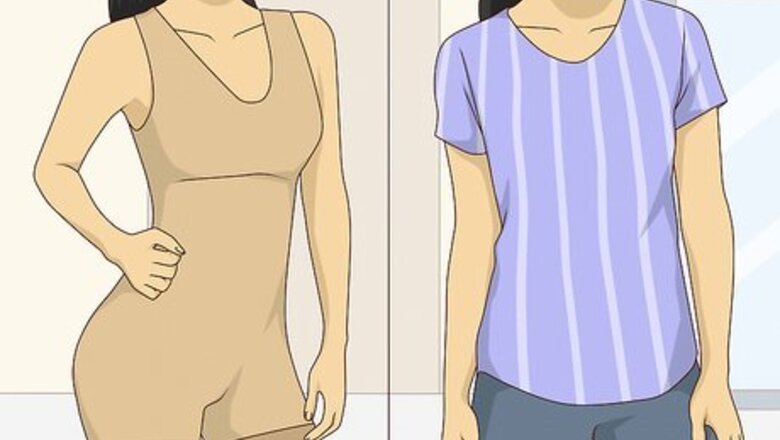
views
Preparing to Take Your Measurements
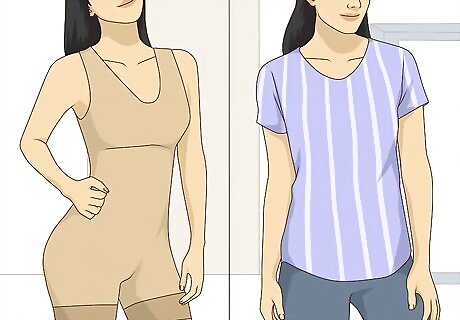
Put on the right undergarments and a thin layer of clothing. While you can take measurements against bare skin, you can choose to slip on a thin layer of clothing. A lightweight t-shirt or tank top are fine, as are leggings or even skinny jeans. Beneath your clothes, different undergarments will result in different body measurements. Remember to put on the specific bra you plan to wear with the garment that’s being tailored or custom-made. For general measurements, try something simple like a non-padded t-shirt bra. To get the correct waist and hip measurements, make sure your undergarments aren’t cinching in your waist. Only wear shapewear if you intend to wear it under your clothes. If you’re taking general measurements, choose undergarments that accurately represent your go-to, everyday undergarments. For instance, if you always wear push-up bras or wear nothing but sports bras, put one of those on instead. Don’t wear anything too thick like a sweatshirt since this will increase your measurements.
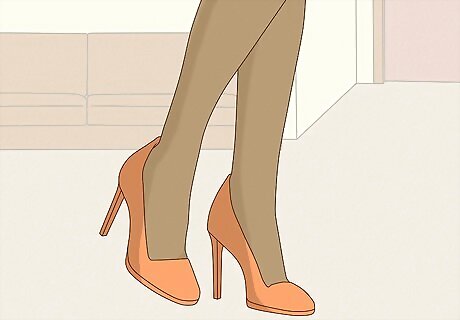
Wear shoes with the correct heel height for hemline or inseam measurements. This is especially important when taking measurements for a dress or pair of trousers. Slip on the shoes you’re planning to wear with your altered clothes, or a similar pair with the same heel height, to avoid too short a hemline. If you’re taking measurements for a bridesmaid dress and you’ve ordered a pair of 4 in (10 cm) high heels to wear for the occasion, put a similar pair of shoes with 4 in (10 cm) high heels. It can be useful to wear the right shoes even if you’re not looking to hem your clothes. Wearing heels changes your posture so it’s best to take measurements of your body as it will be in your clothes.
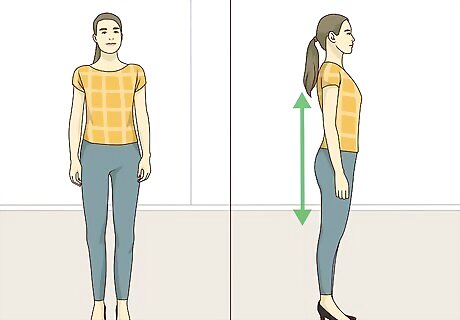
Stand straight up with your feet hip-width apart and your head lifted up. Good posture is the key to accurate measurements. Distribute your weight evenly on both feet, with your feet at least 6 in (15 cm) apart. Don’t shift your weight to one side, or bend your knees since this will throw off your measurements. Focus on looking straight ahead rather than glancing down and bending over your head. If you need to take a break from standing ramrod-straight, that’s ok! Just pause for a moment to relax your body or sit down before resuming. It can be really tempting to bend over and look down to see the tape measure or watch your friend as they help with your inseam measurement. Resist this urge! To help you stay focused, pick a point on the wall to stare at or pretend you’re balancing a book on your head. If you’re standing in front of a mirror, maintain eye contact with yourself.
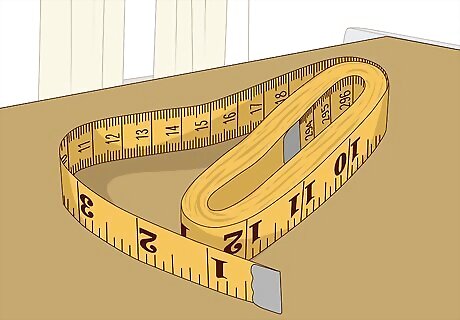
Use a soft measuring tape. Soft fabric and plastic tape measures can be easily found at craft stores and online for a few USD. Some tape measures hang loose while others come on retractable spools. Make sure yours is soft and flexible like a ribbon. A ruler or a metal tape measure (the type used for home improvement projects) aren’t suitable for taking body measurements since they’re not flexible. Don’t use a very old measuring tape. The material might have warped and the notches may be inaccurate.
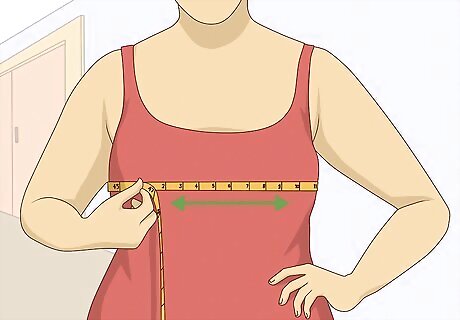
Keep the tape measure completely level when measuring your body’s circumference. When taking bust, waist, and hip measurements, as well as any other horizontal measurement, it's important to keep the tape measure level on all sides as you wrap it around your body. Double-check that the tape measure is level all the way around before confirming the measurement. Looking in a full-length mirror will help you determine if your tape measure is parallel to the ground, or if it’s sagging on one side. Rotate your body while looking in the mirror to make sure the tape measure is completely level. To fix an uneven circumference, slide your fingers beneath the tape measure to correct its position against your body.
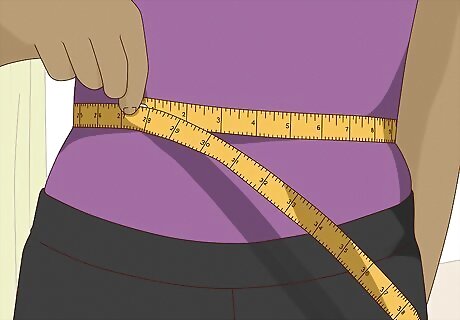
Start at the 0 in (0 cm) end when taking a measurement. If you’re taking a horizontal measurement, such as your waist measurement, position this end at the center of your body and bring the rest of the tape around to meet it. Or, if you’re taking a length measurement such as inseam, hold the end of the tape measure at the starting point and draw the rest of the tape along your body until you reach the stopping point. Where the tape meets the end, or when you reach the stopping point, this will be the number you use for the measurement. If you’re not paying attention, you might start at the 60 in (150 cm) end. This might actually give you believable measurements but they’ll be incorrect.
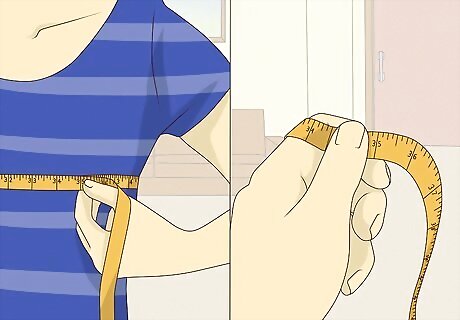
Pinch the tape measure at the correct spot and bring it up to your eye level. If you’re supposed to be staring straight ahead, you might wonder how you’re supposed to see the tape measure. There’s a simple trick to this! While maintaining good posture and looking straight ahead, pinch your finger and thumbnail around the tape measure at the correct spot on the measuring tape. Then bring the tape measure up to your eye level to see where you’ve pinched it. With a secure grip on the tape measure, release the tape from around your body and lift it up to take a closer look. Check to see which line on the tape your thumbnail is sitting at, and use this as your measurement. If your thumbnail is pointing to 31.25 in (79.4 cm) on the measuring tape, write this down as your measurement.
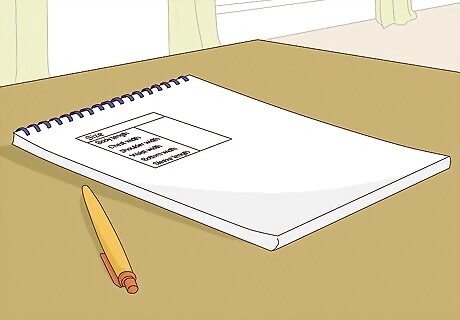
Make a list to write down and organize your measurements. Before taking your measurements, create a simple measurements reference sheet. In column 1, write down the type of measurements. Column 2 should start with blank spaces and in which you’ll write each measurement down as you go. Even if your first column is as simple as “Bust, Hips, Waist” it’s still helpful to write them down. It’s easy to forget these numbers, especially the ones with fractions! If you’re taking a lot of measurements, it can help to have a friend write down the numbers for you. They can also call out the next measurement from the list. If you prefer, print off a measurements diagram so you remember which numbers correspond to each part of your body.
Taking Your Bust and Bodice Measurements
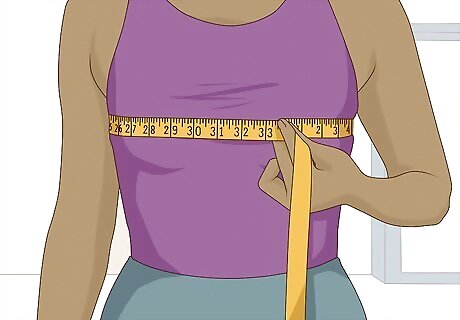
Wrap a tape measure around the fullest part of your bust. Start by holding the end of the tape measure at the center front of your body, in line with the fullest part of your bust. Pass the tape under your arm and wrap it around your back. Bring it back to meet the end in the front. The fullest part of the bust is often in line with the nipples. Keep the tape level and parallel to the floor. Pinch the tape measure at the meeting point and record this number as your bust measurement on your reference sheet.
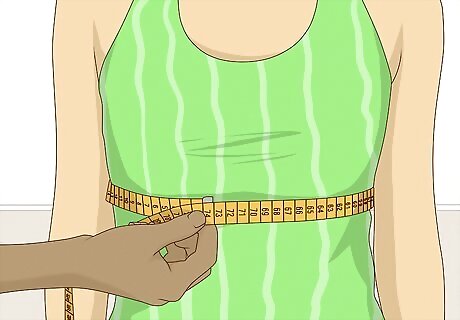
Take your underbust measurement by wrapping the tape around the base of your bra. For the underbust measurement, align the tape measure with the part of your chest that sits directly under your breasts, where the bottom of your bra sits. Use the same technique of placing the tape measure at the center front, wrapping it around your back, under your arms, and pinching the tape where it meets the end in the front. This is sometimes referred to as your band size when you’re getting sized for a bra.
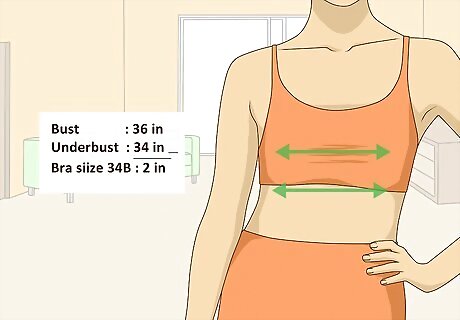
Calculate your bra size by subtracting the underbust from the bust measurement. Once you’ve taken your bust and underbust measurements, you’ll use the underbust number as your bra band measurement (e.g., 32, 34, 36, and so forth). To figure out your cup measurement, round up your bust measurement to the nearest whole number, in inches. Then subtract the underbust number from your rounded-up bust number. Use the difference to gauge your cup size. A difference of 0 indicates an AA cup, 1 indicates an A cup, 2 indicates a B cup, 3 indicates a C cup, 4 indicates a D cup, 5 indicates a DD cup, 6 indicates a DDD or F cup, and 7 indicates a G cup. For instance, if you have a 36 in (91 cm) bust, and a 34 in (86 cm) underbust, that leaves you with a difference of 2. Therefore your bra size is 34B. Add one cup size for each additional inch of difference.
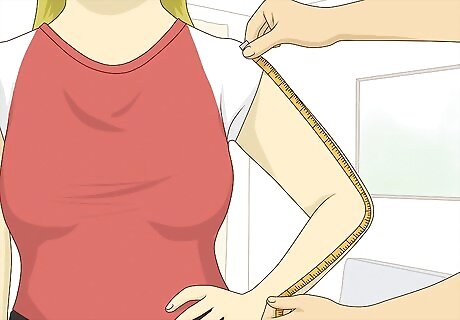
Extend the measuring tape along your bent arm to find your sleeve length. Ask a friend to assist you with this one. Stand with your elbow bent at a 90-degree angle with your hand resting on your hip. Instruct your friend to hold the end of the tape measure at the center of the base of your neck at the back. Have them extend the tape measure to your outer shoulder, down over your elbow, and down to your wrist. They can stop at your wrist bone. Record this number as your sleeve length. This should be one full measurement; don’t break it up into pieces. The sleeve length measurement is used for certain types of formal and custom-made shirts or blouses. You can also extend your bent arm out in front like a doll for this measurement. It just needs to be positioned at 90 degrees.
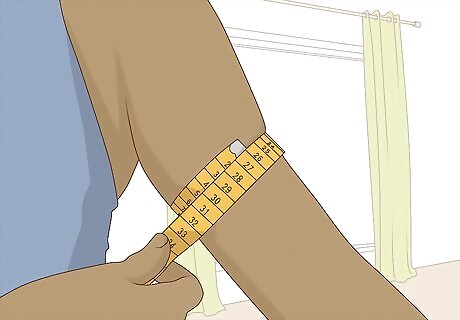
Measure your upper arm circumference for your bicep measurement. Hold your arm down at your side, keeping it slightly away from your body. Wrap a tape measure around the widest part of your upper arm. Where the ends meet, record this as your bicep or upper arm measurement. Use this measurement when ordering a custom-made top or dress with sleeves. Keep the tape measure somewhat taut, but do not let it dig into your skin. Make sure you can slip 1 or 2 fingers behind the tape for comfort. If you have especially large muscles, you may want to record an unflexed and flexed version of this measurement.
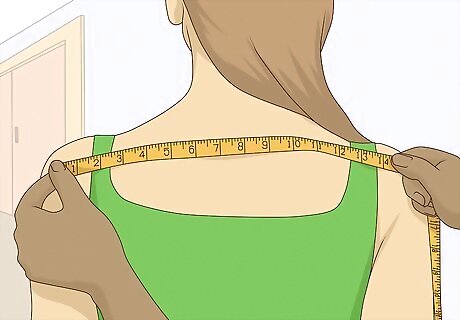
Check the distance between your shoulders at the back for your shoulder width. Stand upright with good posture and relaxed shoulders. Have a friend assist you by holding one end of the tape measure at the outer edge of one shoulder. Instruct them to draw the tape across your back and over to the outer edge of the other shoulder. Keep the tape measure parallel to the floor. Record this distance as your shoulder width. This measurement is most often used for custom tops, blazers and tailored dresses. If you’re taking this measurement on your own, you can raise your arms up as you get the tape into place. But keep your elbows close to your body as you pinch the tape to determine the measurement. Follow the same process in the front for your front shoulder width.
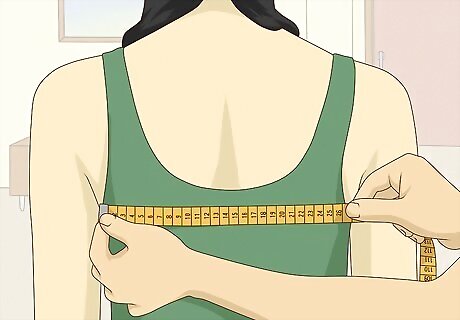
Measure the distance between your armpits for the low chest or low shoulder length. A friend can help you take this measurement. Ask them to position the end of the tape measure at the point where your arm connects with your torso. This is known as the armscye. Then instruct them to pass the tape across your lower shoulder blades at the back, bringing to the armscye at the other side. They should hold it parallel to the ground. Record the distance as your low shoulder or low chest measurement. This measurement may be used for custom-made tops, blazers, and dresses. Think of the armscye as the armhole on a t-shirt. This measurement is sometimes called armscye-to-armscye measurement, and can be taken at the front and back of your torso. Stand in front of a full-length mirror with your back straight and your shoulders relaxed. Extend the tape measure from the middle of the shoulder blades, at the base of one arm to the other. This will also be the distance from the center of one armhole to the other. Keep the tape parallel to the floor.
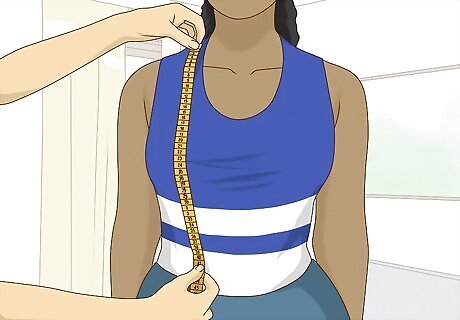
Take your shoulder-to-waist measurements for a bodice. Stand with your back straight and your shoulders relaxed. Ask a friend to hold the end of the tape measure at the top of your shoulder, where your shirt’s shoulder seam would be. Have them extend the tape measure down across your bust until they reach your natural waist. Have your friend take your shoulder-to-waist measurements from the front and back sides of your body. For additional detail, take your nape-to-waist measurement in a similar way. Start with the tape at the base of your neck in the back, and bring it to your natural waist. These measurements may be used for custom tops, blazers and tailored dresses.
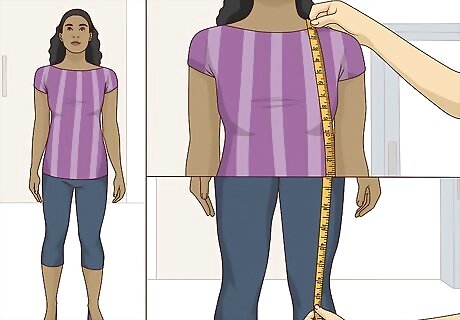
Measure your dress length from your shoulder to your desired hemline. Stand with your back straight and your legs hip-width apart. Have a friend hold the end of the tape measure at the top of your shoulder. Ask them to extend the tape measure along the front of your body, passing over your bust and reaching down to your desired hemline. Your ideal hemline could be slightly above or below the knee. It might also be just above the floor for a maxi dress or full-length gown. This is a measurement used for dress shopping and tailoring. To take your skirt length, follow the same procedure but start at your natural waist instead of your shoulder.
Taking Your Waist, Hip, and Leg Measurements
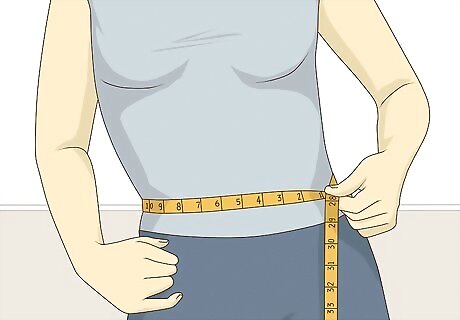
Identify your natural waist. While standing upright, bend over to the front or side and make a note of where your body creases. This is your natural waist. It's the narrowest part of your torso, generally located between your rib cage and belly button. If you plan to take lots of measurements that relate to your waist, such as rise, it can be handy to tie a thin string around your natural waistline. This way you don’t have to keep finding it all over again!
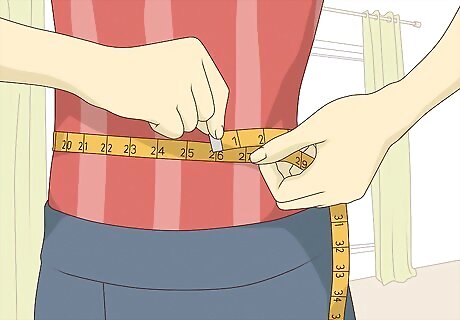
Find your waist measurement by wrapping the tape around your natural waist. Keep the measuring tape parallel to the floor as you extend it around your waistline. Don’t hold your breath or suck your stomach in since this will result in an incorrect measurement. Be sure you don't draw it too tight. Slip 2 fingers under the tape to make sure it isn't pulled too tight. Without slouching or looking down, pinch the tape measure where it meets together. Record this number as your waist measurement.
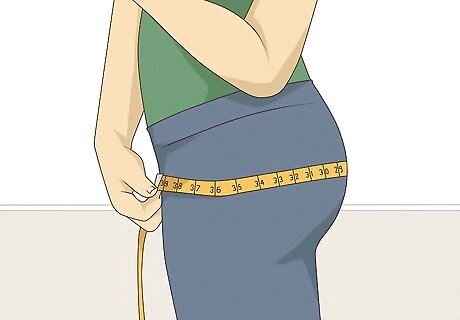
Wrap the tape around the fullest part of your buttocks for your hip measurement. The hip measurement refers to the widest part of your lower torso, which is usually located about 7 to 9 in (18 to 23 cm) below your natural waist. This may be quite low on your pelvis. Keep the tape measure parallel to the floor as you hold it in the front, extend it around the back of your body, and bring it to meet in the front. Double-check that that tape measure is parallel, since this measurement can be easy to get wrong, before pinching the tape and looking to see what the final measurement number is. Record this number on your reference sheet. Though it’s called the hip measurement, you shouldn’t measure the circumference in line with where you can feel your hip bones at the front of your body. This part of your body is typically narrower than your buttocks.
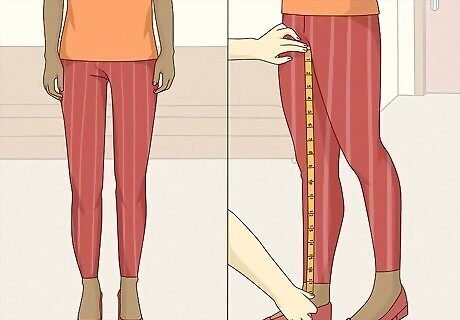
Find out your inseam by measuring the length of your inner leg. For this measurement, enlist the help of a friend. Standing straight up with your feet hip-width apart, hold the tape measure at the highest point of your crotch. As your friend to bring the tape measure down the inside of your leg. The should stop at the base of your ankle bone to take the standard inseam measurement. If you’re taking measurements to hem a pair of trousers, have your friend bring the tape measure all the way down to where you want the hemline to sit. Remember to take your shoes' heel height into account. For instance, if you’re hemming a pair of wide-leg trousers that you’ll wear with heels, put on your high heels and have your friend measure down your leg and foot until they reach ⁄4 in (0.64 cm) above the floor.
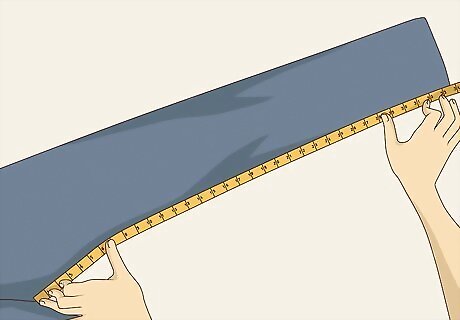
Use a well-fitting pair of trousers or jeans to measure your inseam. If you can’t find anyone to assist with your inseam measurement, select your best fitting pair of jeans or trousers to measure your inseam. Spread open the trousers and use your tape to measure the distance from the crotch to the hem on one leg. The inseam measurement is used for trousers and jeans. It’s especially helpful when determining which trouser length to search for.
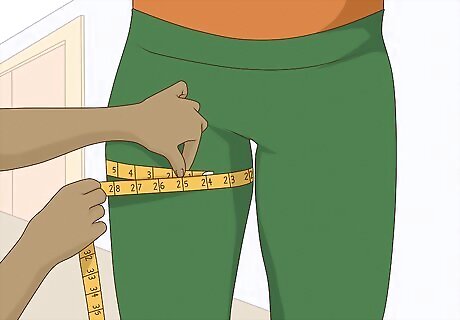
Encircle your upper leg with the tape to take your thigh measurement. Stand with your feet hip-width apart and have a friend wrap the tape measure around the fullest part of your thigh. They should keep the tape parallel to the floor and pinch the tape where it meets together in the front. Record this number as your thigh measurement. The thigh measurement is most often used for stockings and custom-made trousers. The fullest part of your thigh may be higher up than you expect. Make sure to measure the widest part of your upper leg to get the most accurate measurements. If you’re doing this yourself, you’ll have to bend over to reach your upper leg. Bend over at your hips instead of bending your knees, since this might throw off your thigh measurement. Follow the same process at different points along your leg to determine your knee, calf, and ankle measurements.
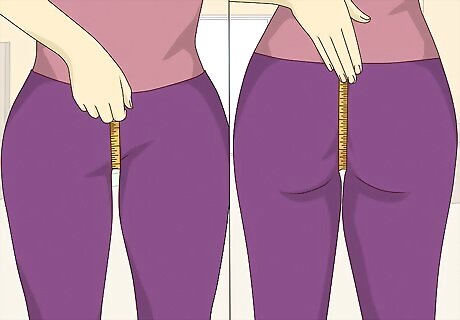
Measure the bottom half of your torso for the half girth measurement. Tie a string around your natural waist first. Then place the end of the tape measure in the center front, in line with the string marking your natural waist. Pass it between your legs and bring it up to the back, maintaining good posture and looking straight ahead. Line it up with your natural waist at the back and pinch this part of the tape. Release the tape from around your body and look to see where your finger has marked the measurement. Record this has your half girth. To determine your full girth measurement, pass the tape measure over one shoulder, from the back to the front, and bring the tape to meet in the front at your natural waist. Girth measurements are typically used for custom-made trousers and leotards. The half girth measurement is sometimes called rise. But keep in mind that rise is sometimes recorded as half of this measurement, and is taken from the natural waist to the chair when you’re seated. If someone’s asked you to provide these measurements, confirm exactly what information they’re asking for to avoid confusion.














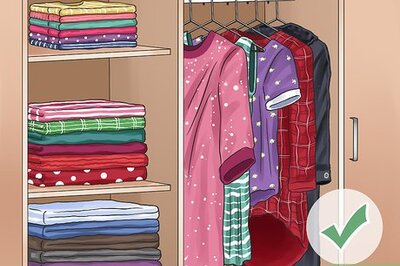


Comments
0 comment